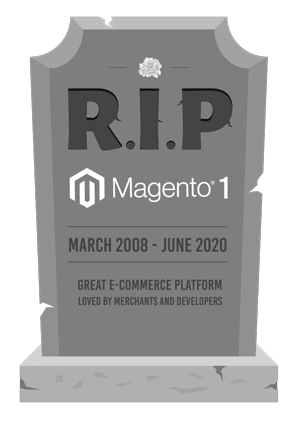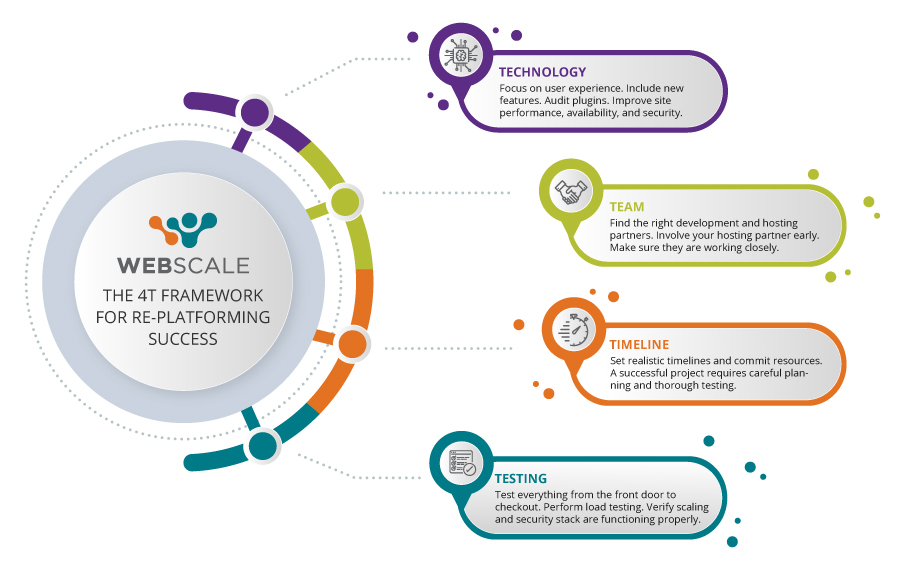June 2020 – for many online merchants and Magento developers, it’s a date that’s already burned into memory. Magento 1 will end of life and with that, no further features, functionalities, or security updates/patches will be made available. The scariest part of this is, probably, that Magento 1 sites will be increasingly vulnerable to cyber-attacks.
If you’re not already planning your re-platform to Magento 2, it’s time to start.

Re-platform, Not Upgrade
When going from Magento 1 to 2, it’s important to know what you’re getting into. Magento 2 is an entirely new platform with substantial framework differences and a very dissimilar hosting backend. From a development standpoint, a Magento 2 site needs to be built from the ground up, requiring significant resource and time commitments.

Finding the right development and hosting partners can be hard with so many options (and a ton of marketing fluff) out there. Project management and estimating timelines can be tricky, especially if you haven’t done this before.
It’s also important to address user experience, scalability, performance, and security issues, as these are different for a Magento 2 site. For example, Magento 2 handles load differently from Magento 1, so it can be hard to forecast how a site’s scaling needs will change after the transition.
Finally, it’s imperative to ask yourself, “how do I know it’s going to work?”
Magento 2: An Opportunity
Most Magento 1 sites are evolutions; some have been undergoing incremental changes for almost a decade. Re-platforming to Magento 2 could be an opportunity to go back to the drawing board and deliver a brand-new, world-class user experience. It’s also a chance to take advantage of the latest Magento features and functionalities.
Furthermore, you can devote some project cycles to evaluate (or re-evaluate) all your options from a development, infrastructure, and hosting perspective – things like, your choice of hosting provider, development partner, CDN, security solution stack, etc.
The 4T Framework for Re-platforming Success
At Webscale, we have helped dozens of merchants with their Magento re-platforming efforts. Based on our learnings, experiences, and successes, we built a framework around 4 Ts – best practices surrounding the most important factors to ensure re-platforming success.

1. Technology
- Focus on user experience, above everything else, when including new features and functionalities in your Magento 2 storefront.
- Audit plugins/APIs, their compatibility with the new environment, and impact on performance and security. Upgrade or replace plugins/APIs, as necessary.
- Improve site performance by leveraging content and page optimization techniques. Set up site cache for faster page loads. Consider alternatives to Varnish (for example, Redis).
- Enhance site availability by setting up auto-scaling correctly to accommodate variable load and unexpected traffic peaks.
- Make sure you have a robust security stack. Have custom WAF rules, intrusion detection, DDoS mitigation, bot management, etc. in place and implement a Content Security Policy to mitigate different types of cyber-attacks.
2. Team
- Find the right development and hosting partners to work with, ideally teams that have executed re-platforming projects at your scale successfully, for several other merchants.
- Evaluate (or re-evaluate) your development and hosting teams. You might even want to talk to your hosting partner and evaluate other hosting alternatives. Whichever path you choose, involve your hosting partner sooner, rather than later.
- Make sure your development and hosting partners are compatible and working closely.
3. Timeline
- Switching from Magento 1 to 2 is a complete re-platform, as the work required goes beyond a simple upgrade, with customizations or extensions. One of our prospects had a 16-hour outage because they tried to take their existing Magento 1 site and upgrade it on the fly, in production, with only a two-hour maintenance window. They ended up quickly rolling back to fix all the changes during the outage.
- The time needed for a re-platforming project can vary greatly, depending on the scale, development effort, and complexity of the build (including the number of off-the-shelf solutions, APIs, and integrations being used in the existing site).
- A successful re-platforming project requires careful planning and thorough testing throughout the process. This takes time.
- Set realistic timelines and commit resources after taking into account the expected outcomes and required effort.
4. Testing
- Test everything from the front door to checkout, before the Magento 2 site goes live. We recommend up to 3 months of complete testing to ensure a smooth transition.
- Perform load testing before the migration. Simulate production traffic against test/staging environment and see how it performs. (Magento 2 handles load differently from Magento 1.)
- Verify scaling and the security stack are functioning as required. Ensure site performance meets expectations.
How prepared are you to re-platform from Magento 1 to Magento 2? If you’re in need of advice from experts that have done this for dozens of merchants already, we’d love to help. Drop us a line at sales@webscale.com for more info.
You can also check out my presentation at Meet Magento NYC 2019 on this topic, along with Magento Master TJ Gamble (CEO of Jamersan). Watch the video here.







